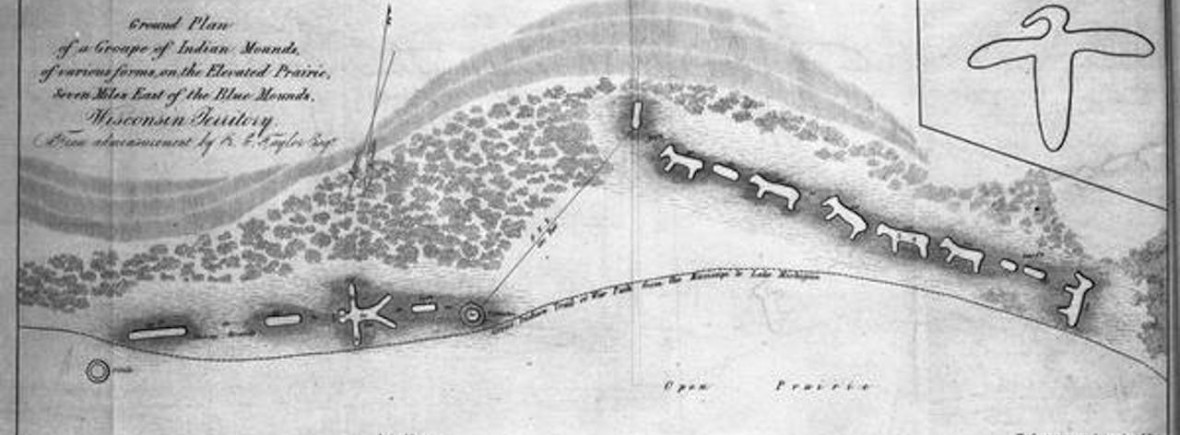What are the Effigy Mounds?
Effigy mounds were built between the years 700 and 1200 C.E., by Native Americans during the Late Woodland period. While mounds were built on land that is now part of Wisconsin previous to the Late Woodland period, these earlier mounds tended to be conical or geometric. They were not effigy mounds, as the term “effigy” refers to that fact that the mounds were built in the shapes of animals important to the Late Woodland people. Many effigy mounds were constructed near earlier mound sites. The building of additional conical or linear mounds often accompanied the creation of effigy mounds.
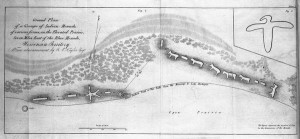
A map diagram of Indian effigy mounds seven miles east of Blue Mounds in the Wisconsin Territory produced in 1838. Wisconsin Historical Society Image 5173.
The Late Woodland people who built the effigy mounds obtained most of their resources by hunting and gathering. Deer, nuts, berries, and other edible plants formed the majority of their diet. People moved throughout the year, following food sources. In order to do so, they lived in portable, single-family homes that resembled wigwams. Towards the end of the Late Woodland period, the cultivation of crops became increasingly important, and corn in particular became a major food source. House construction during this period also changed. More permanent structures were built on top of shallow, key-hole shaped pits. Within these dwellings, called pit-houses, other clues that point towards a more sedentary lifestyle have been found. The remains of clay pots suggest that food was stored instead of used immediately. Additionally, some of the pit-houses were large enough to fit several families or serve as a meeting place. Archaeologists have found several Late Woodlands villages located near mound groups. For instance, the Camp Indianola site, on the shore of Madison’s Lake Mendota, is only a short distance from a mound group found at Governor Nelson State Park.
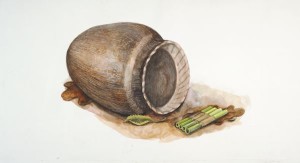
A watercolor of a piece of pottery and a pan pipe created by Late Woodland mound builders of Wisconsin. Wisconsin Historical Society Image 33805.
The effigy mounds functioned as burial mounds. In fact, archaeologists have found no other significant burial grounds created by the Late Woodland people who lived in the area that is now Wisconsin, suggesting that effigy mounds served at the primary mode of burial during this period. In contrast to the conical mounds built by earlier Native Americans groups, effigy mounds typically contain only one body, or at most several. A few excavated mounds contain no bodies at all. In addition to the bodies of deceased Late Woodlands people, elaborately decorated pottery, know as Madison ware, tobacco pipes, tools, and other small offerings have been found in mounds. Lavish offerings to the dead were uncommon, though several exceptions exist, including one young women buried with a full set of deer antlers laid across her legs.
Building the Mounds
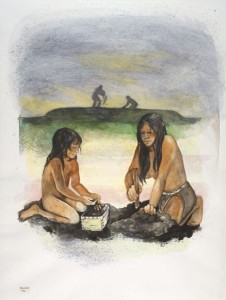
A watercolor of Late Woodland people building an effigy mound. Wisconsin Historical Society Image 33815.
Effigy mound building occurred in intervals, which could have been as frequent as annually.The construction of an individual mound, however, typically took place at one time. As such, the dirt contained within the mounds is not layered or stratified. The shape of existing landforms played a large role in the building of the effigy mounds. The mounds were built in harmony with the hills, ridges, and wetlands upon which they sit. The practice of building effigies mounds so that they followed the curve of the land, coupled with the fact that the mounds are no more that three to four feet high, accounts for the lack of borrow areas or holes in the land near the mounds. Many mounds fit so well within their natural landscapes that it can be hard to determine where they actually end, making size estimation difficult. Most effigy mounds were less than 100 feet long, but several mounds of truly astonishing scale still exist. One of the giant bird effigy mounds preserved on the grounds of Mendota State Hospital has a wingspan of 624 feet.
After choosing a site for construction, the builders sometimes first dug out a shallow “shadow mound” in the shape of the effigy. Bodies and other items that were to be interned were placed either on or near the surface of the earth before the building process. Then the mound itself was constructed by scraping or sculpting the nearby land into the desired shape. Bodies were typically buried in mounds as bundles of bones, though some have been found in the “flex,” or fetal, position. The presence of both types of burial suggests that these bodies were not buried immediately after death, but rather stored for some time. This would have been especially true in the case of a death in the winter months, when the frozen ground would have made mound construction difficult.
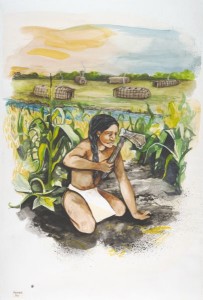
This drawing depicts how life may have looked in the Oneota period (900 – 1650 C.E.). Wisconsin Historical Society Image 33806.
By 1250 C.E., the Four Lakes area and other sites of mounds activity had been abandoned. It is possible that the effigy mound builders were dispersed by climate change, or entered into a period of warfare with other tribes, like the southern Mississippians. Another theory is that the Late Woodland people may have joined the Mississippians creating a new dominant culture, called the Oneota, which was distinguished by new forms of pottery, farming, and more permanent settlements. Whatever the reason, the thirteenth century brought cultural change to the Four Lakes region and the practice of building effigy mounds was gradually abandoned.
From Excavation to Conservation
The first wave of white settlers came to Wisconsin in the early nineteenth century. They quickly discovered the large earthworks left behind by the Late Woodland people. Increase Lapham, a land surveyor from Ohio, became one of the first to study the effigy mounds in-depth. In 1855 Lapham published the book Antiquities of Wisconsin, which served as the first systematic attempt to document and map Wisconsin’s effigy mounds. Lapham’s work remains useful to scholars working with the mounds today.
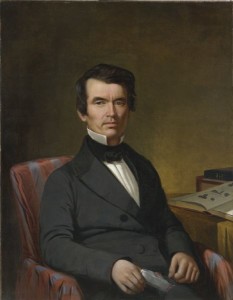
Increase Lapham (1811-1875) was one of the first people to systematically catalogue Wisconsin’s effigy mounds. Wisconsin Historical Society Image 2758.
Surprisingly, mound researchers in the mid to late-nineteenth century did not consider contemporary Native Americans as possible mound builders. They argued that mound construction was required complex planning and organization, which they believed would have been impossible for the local tribes of Wisconsin to achieve. Their unwillingness to recognize the possibility that the mounds could have been built by the ancestors of these tribes may also have been motivated by political concerns. Throughout the nineteenth century, early Wisconsin settlers and the United States government itself clashed with Native American tribes over land. The violence that broke out over territory was much easier to justify if it was possible to argue that Native Americans had not cultivated the land. If they were shown to be the builders of the mounds, not only would this serve as evidence of their stewardship of the land, but also of the complexity of Native American society.
If the Native Americans could not have built the mounds, then they must have been built by others. Many theories surfaced as to the identity of the mound builders in the nineteenth century. One writer argued that the effigy mounds were built by the people of Atlantis. A similar idea that gained greater credence was the “Lost Tribe” theory. According this theory, the mounds were built by one of the biblical lost tribes of Israel. The “Lost Tribe” theory was particularly attractive because it connected the United States to the Holy Land, and fed into narratives of a heroic American past.
As mound research progressed and came to employ more sophisticated methods of investigation and technology, it became clear that Native American tribes had indeed built the mounds. A debate still remained over whether the tribes living in Wisconsin were the ancestors of the mound builders. Today, many researchers believe that the Ho-Chunk tribe may be descended from the mounds builders.
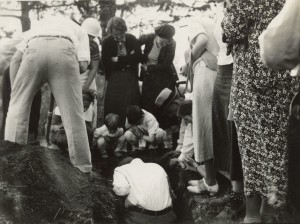
Members of the Wisconsin Outing Club watch the excavation of a burial mound at the Outlet group in 1935. Wisconsin Historical Society Image 38954.
Mound excavation and research continued into the twentieth century. At the same time, it became increasingly clear that the mounds themselves need protection. In the early 1900s amateur mound excavation became a popular Sunday leisure activity. Other mounds were destroyed as land was converted to farmland.
In 1899 the Wisconsin Archaeological Society was established. The society claimed as its mission “advancing the study and preservation of Wisconsin Indian Antiquities.” A year later Charles E. Brown joined the society. Brown, more than any other figure, devoted himself to the preservation of Wisconsin’s mounds. In 1901 he helped found the Wisconsin Archaeological Society, and in 1912 he established the Mounds Preservation Committee. By 1920 the Mounds Preservation Committee had succeeded in protecting over 500 mounds. Brown was also instrumental in ensuring that the mounds at Aztalan became a public site in 1920. A committee formed by Brown in 1911 even achieved the monumental task of passing a law to protect antiquities on public lands. This law was Wisconsin’s first historic-preservation law, and provided yearly funds for state-wide mound inventory. Sadly, the program funding mound protection lasted only two years. State funds were not allotted for mound research and protection again until the 1970s.
Brown’s efforts ensured that over 200 mounds were preserved in the Madison area today. In contrast, in Milwaukee, which had also been a center of mound activity, no mounds remain. Brown’s work often brought him into conflict with government officials and institutions around Madison. For example, in the late 1930s the University of Wisconsin allowed several mounds to be destroyed in order to make room for new facilities. Brown publicly critiqued the university, calling their actions “criminal.” Happily, the university responded positively to Brown’s critiques, promising to preserve the campus mounds in the future. In 1939, Brown was brought on to advise the University of Wisconsin on how best to protect their acquisition of the mounds at Picnic Point.
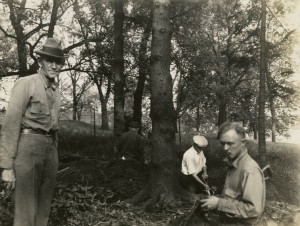
Charles E. Brown (left), directs the excavation of a goose effigy mound at the Willow Drive mound group on the University of Wisconsin-Madison campus. Wisconsin Historical Society Image 38995.
Brown and his peers continued to lead mound-mapping excursions and excavations during the mid-twentieth century, but general interest in the mounds waned in the 1940s. National events like the Great Depression siphoned funds from preservation programs, and World War II drew attention overseas. Mound research continued, but at a much diminished rate. During the 1950s, inquiry into the sites in which mounds builders lived help pique interest in the mounds, but overall the amount of funding and attention given to research remained low.
In the 1970s increasing respect for Native American cultures renewed interest in the effigy mounds. As this interest spread to the public through the production of new knowledge about the mounds, mound preservation again became an issue. Surveys of mound locations carried by academic and research institutions in the 1970s suggested that as much as 80% of the mounds mapped by early figures like Lapham no longer existed. Fortunately, many of the mounds listed as missing have since been found and preserved.
The Effigy Mounds Today
Wisconsin is home to thirty mound groupings listed within the National Register for Historic Places, and eleven of these sites are in Madison! Today, both federal and state legislation protects mounds and burial sites from development. The Native American Graves Protection and Repatriation Act of 1990 protects existing human remains on federal and tribal land. Additionally, the 1985 Burial Sites Preservation Law in Wisconsin protects all burial sites on public and private lands from disturbance, with a minimum five foot buffer zone surrounding each mound.
Many groups within Wisconsin are currently involved in mound preservation. Both the Cultural Landscape Legacies and the Three Eagles Foundation provide education and outreach on the mounds, and work to protect them. In 2006, the Lower Wisconsin State Riverway Board collaborated with Cultural Landscape Legacies, the Ho-Chunk Nation, the Wisconsin Department of Natural Resources, and other stakeholders to develop protocol related to protecting mounds and other cultural resources on public and private lands. These guidelines include site assessment, mapping, and mounds maintenance through a phased approach of activities such as mowing, burning, trails, signage, repair, and restoration.
Today, the Wisconsin State Historical Society, other archaeologists, and interested citizens continue Wisconsin’s tradition of mound research. Because of the passage of the Burial Sites Preservation Law in 1985, it is now illegal to disturb a mound site. Excavation is done only in salvage situations, when the mound’s contents would otherwise be lost. Occasionally, new knowledge is produced through the use of ground-penetrating radar, which allows researchers to scan the mounds for anomalies. This practice, however, is somewhat controversial in cases where the mound contains a body. Other knowledge about the mounds comes from continued study of the Native American traditions. While we have learned quite a bit about the beautiful effigy mounds that grace Madison’s landscape, much remains a mystery.
Back to Top | Effigy Mounds Main Page | Reading the Mounds | Visiting the Mounds
